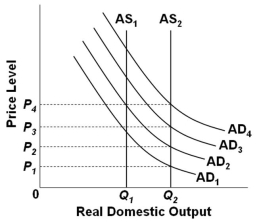Multiple Choice
 Refer to the graph above. Assume that the economy is initially in equilibrium at the intersection of AD1 and AS1. Suppose that there is economic growth which shifts AS1 to AS2. Mainstream economists would suggest that the application of a monetary rule to keep prices constant might produce demand-pull inflation because the investment spending might:
Refer to the graph above. Assume that the economy is initially in equilibrium at the intersection of AD1 and AS1. Suppose that there is economic growth which shifts AS1 to AS2. Mainstream economists would suggest that the application of a monetary rule to keep prices constant might produce demand-pull inflation because the investment spending might:
A) Increase and cause the aggregate demand curve to shift from AD1 to AD4
B) Decrease and cause the investment demand curve to shift from AD1 to AD4
C) Increase and cause the aggregate demand curve to shift from AD1 to AD2
D) Decrease and cause the investment demand curve to shift from AD1 to AD2
Correct Answer:

Verified
Correct Answer:
Verified
Q17: Within the aggregate demand-aggregate supply framework, a
Q18: Monetarists argue that the relationship between:<br>A) The
Q19: The view that anticipated changes in the
Q20: The "efficiency wage" is one possible explanation
Q21: The idea that business fluctuations are primarily
Q24: From a rational expectations perspective, an easy
Q25: From the mainstream perspective, instability in the
Q26: In the monetarist view:<br>A) Changes in investment
Q143: Rational expectations theory suggests that people make
Q238: Real-business-cycle theory views changes in resource availability